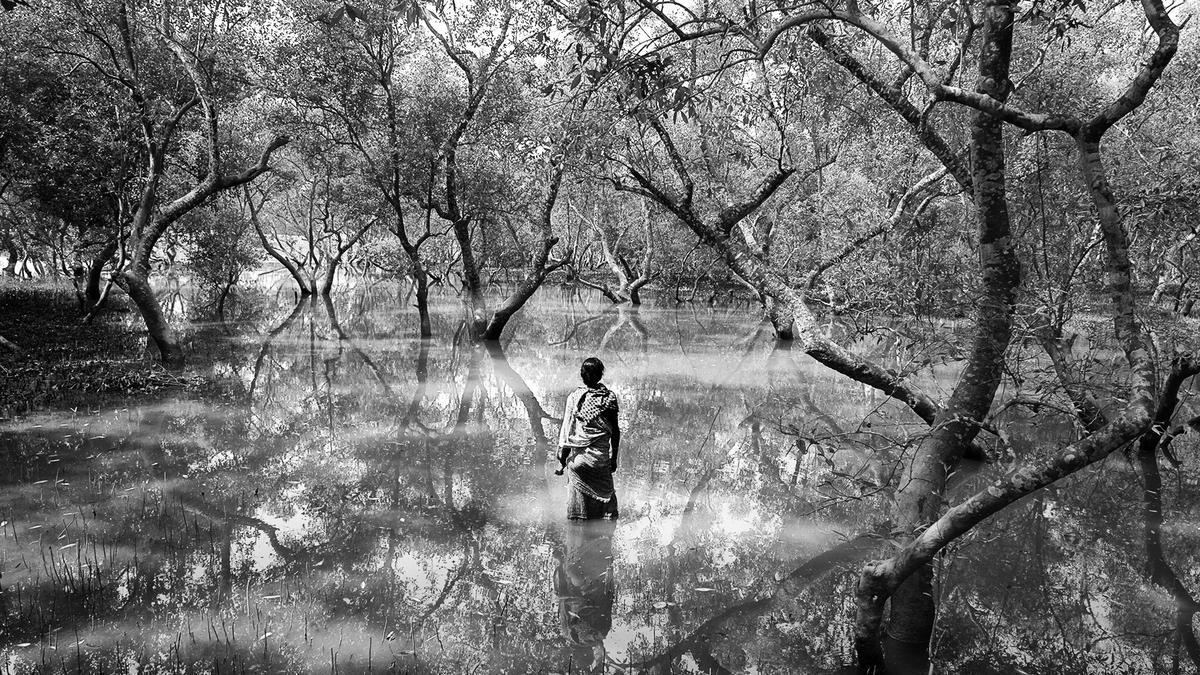
Surviving the shadowlands: Interview with Arati Kumar-Rao, artist and author of Marginlands
The Hindu
Arati Kumar-Rao, artist and author of Marginlands, brings us stories of people who inhabit the most hostile corners of the subcontinent in her new book
Chhattar Singh draws water from the belly of a dune in Rajasthan’s Thar desert. In West Bengal, Tarikul bhai lost everything to the Ganga after the construction of a barrage and has rebuilt his life several times over. In the Sundarbans, a crab-hunter, Asit Mandal, shifted to farming after a tiger dragged him by the head ashore. Author, artist and photographer Arati Kumar-Rao, in her new book Marginlands, captures the tumultuous lives – both human and non-human – of those who inhabit the margins of the subcontinent.
In her travels across some of the most hostile environments, for which she often took personal loans and exhausted her savings, she has been fortunate to have sighted the endangered Indus dolphin in the Beas, its “teeth gleaming white through its trademark ‘smile’”, and saved herself, just in time, from toxic corals in Goa’s tidepools. In one chapter, Kumar-Rao recounts the distressing tale of a hilsa fisherman’s young son who was kidnapped by pirates in Bangladesh’s Sundarbans. The gangs, she is told, notoriously course the waters at night, armed with Chinese-made 0.22 rifles, looking to abduct fishermen they release for a ransom. The boy was freed nine days later, after his parents paid up 20,000 taka (approximately ₹15,000).
Kumar-Rao, who has always been drawn to the imagery in the storytelling of Rabindranath Tagore and Satyajit Ray, believes in ‘long observations’; it takes her back multiple times to the places she has visited so she can “follow the lives of people I’ve come to know, who are intimately tied to those landscapes.” Edited excerpts from an interview:
It’s hard to pick one. Each experience was so strong. I feel like I carry them within me. Perhaps the one person who influenced me deeply and early on, was Chhattar Singh. The way he saw the land and experienced it, his reverence for life-giving water and flora, his deep understanding of the desert’s rhythms and interconnectedness taught me how to read landscapes. Moreover, he was a man who never hurried; he took his time and allowed things to happen. That, I have come to realise, is the essence of harmony. The story of the desert’s water resilience is something that moved my core and schooled me in many ways.
I’m guided by landscapes, by what plans we have for them, and by warnings that fall on deaf ears. I go to places not because they are already margins — they’re not — but because that is where these issues seem to be playing out. I follow trails, gather strings. And what becomes clear is that we seem to be systemically pushing large swathes of our society to the edge: a fallout of how we treat the land. In this age of the Anthropocene, with climate change upon us, the worst thing we can do is undermine the innate resilience of the land. Unfortunately, that is exactly what we end up doing.
I met Paul at the Wagah border and we set off to walk through India, starting in Punjab and then into Rajasthan. He had walked out of Africa, in Ethiopia, through Turkey and the Caucasus, through the Stans and into Pakistan and arrived at India’s doorstep. Paul takes the walk seriously, there is no other kind of transport involved. We simply woke up every morning, hefted our backpacks, and walked. Walking teaches you to read the land with everything you have. Human interventions like the Harike Barrage and the green revolution have changed the landscape and livelihoods here; while walking along the canal that carries Himalayan waters of the Beas to the Thar we saw the changes and the pitfalls of such engineering quite plainly.
Words, photos, art, sound… these are simply tools we all employ to tell stories. I’m not trained as an artist, I’m simply experimenting, teaching myself to see. Illustrating teaches you to observe closely, details photography tends to miss. Photography is all about seeing and feeling the quality of light. All of these are layers in a story. They have information. They allow me to see the story in different dimensions. I also use photography as a memory-enhancer, taking a lot of documentary shots, just so I remember how something looked at that time of the day. If there is a particular tool a fisherman is using, or some scene described that I find moving, I make a sketch in my notebook. All of this helps when I sit down to write.





















 Run 3 Space | Play Space Running Game
Run 3 Space | Play Space Running Game Traffic Jam 3D | Online Racing Game
Traffic Jam 3D | Online Racing Game Duck Hunt | Play Old Classic Game
Duck Hunt | Play Old Classic Game











